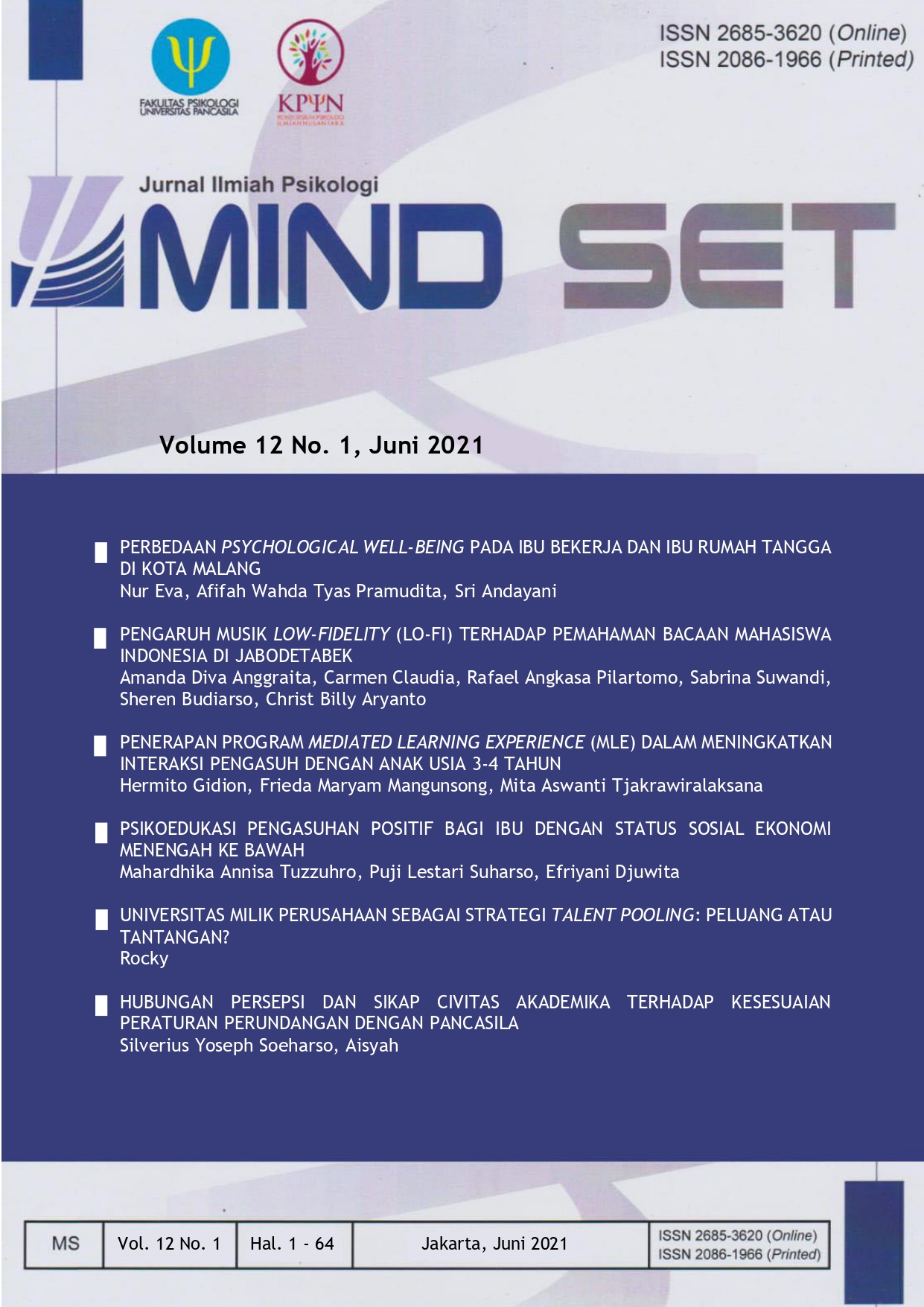Universitas Milik Perusahaan sebagai Strategi Talent Pooling: Peluang atau Tantangan?
DOI:
https://doi.org/10.35814/mindset.v12i01.1555Kata Kunci:
universitas milik perusahaan, ketertarikan organisasi, talent poolAbstrak
Beberapa perusahaan di Indonesia membuat universitas sebagai bagian dari bisnis unitnya. Selain bertujuan untuk mendidik generasi muda, universitas yang dimiliki perusahaan atau company-owned university juga berusaha untuk mendapatkan talenta muda ke dalam perusahaan. Oleh karena itu karyawan senior sering diberikan tugas untuk membagikan ilmu di universitas milik perusahaan tersebut. Walau begitu strategi ini dapat menjadi berbahaya jika lulusan universitas bergabung ke perusahaan pesaing. Penelitian ini bertujuan untuk melihat apakah universitas milik perusahaan menjadi strategi yang baik untuk mencari talenta baru. Konstruk yang digunakan dalam penelitian ini adalah ketertarikan organisasi; sikap positif seseorang terhadap organisasi. Metode kuantitatif digunakan dalam penelitian ini. Sebanyak 474 mahasiswa (178 laki-laki dan 296 perempuan) menjadi responden dalam penelitian dan dibagi menjadi dua kelompok; mereka yang berkuliah di universitas milik perusahaan dan mereka yang berkuliah di universitas lain. Teknik analisa uji beda t-test digunakan untuk membedakan dua kelompok tersebut. Hasil penelitian menunjukkan perbedaan yang signifikan antara mahasiswa di universitas milik perusahaan (M=54,07 SD= 7,937) dan mahasiswa universitas lain (M=51,69 SD= 7,716); t(472)= 3,309; p=0,001. Hasil ini menunjukkan bahwa mahasiswa yang berkuliah di universitas milik perusahaan lebih tertarik untuk bekerja di perusahaan yang mendirikan universitas tersebut daripada mahasiswa yang berkuliah di universitas lain.
Referensi
Ahamad, F. (2019). Impact of word-of-mouth, job attributes and relationship strength on employer attractiveness. Management Research Review, 42(6), 721–739. https://doi.org/10.1108/MRR-11-2017-0382
Alnıaçık, E., & Alnıaçık, Ü. (2012). Identifying dimensions of attractiveness in employer branding: effects of age, gender, and current employment status. Procedia - Social and Behavioral Sciences, 58, 1336-1343. https://doi.org/10.1016/j.sbspro.2012.09.1117
Aslan, G., Alinçe, M., Araza, A., & Dural, S. (2019). Organizational Attractiveness: an Empirical Study on Students’ Public or Private Sector Choice. (14).
Banirestu, H. (2018). BUMN University Bersiap Hadapi Revolusi Industri 4.0.
Baporikar, N. (2015). Role of corporate universities in higher education. International Journal of Applied Management Sciences and Engineering, 2(1), 30-43. https://doi.org/10.4018/ijamse.2015010103
Benraiss-Noailles, L., Herrbach, O., & Viot, C. (2019). The impact of employer brand equality on organizational attractiveness: The moderating role of familiarity. Management & Avenir, 107, 37-59.
Creswell, J. W. (2012). Educational Research: Planning, Conducting, and Evaluating Quantitative and Qualitative Research. In Educational Research (Vol. 4). https://doi.org/10.1017/CBO9781107415324.004
Etikan, I. (2016). Comparison of convenience sampling and purposive sampling. American Journal of Theoretical and Applied Statistics, 5(1), 1. https://doi.org/10.11648/j.ajtas.20160501.11
Gerald, B. (2018). A brief review of independent, dependent and one sample t-test. International Journal of Applied Mathematics and Theoretical Physics, 4(2), 50. https://doi.org/10.11648/j.ijamtp.20180402.13
Gomes, D., & Neves, J. (2011). Organizational attractiveness and prospective applicants’ intentions to apply. Personnel Review, 40(6), 684-699. https://doi.org/10.1108/00483481111169634
Hendriks, M., Bondarouk, T., & Bos-Nehles, A. C. (2016). Organizational reputation, organizational attractiveness and employer branding: clarifying the concepts. (October), 115.
Highhouse, S., Lievens, F., & Sinar, E. F. (2003). Measuring attraction to organizations. Educational and Psychological Measurement, 63(6), 986-1001. https://doi.org/10.1177/0013164403258403
Jatmiko, P. B. (2004). The influence of firm ecological recruitment advertisements on organizational attractiveness and career choices: An experimental research. Gadjah Mada International Journal of Business, 6(2), 155-169. https://doi.org/10.22146/gamaijb.5549
Kashive, N., & Khanna, V. T. (2017). Study of early recruitment activities and employer brand knowledge and its effect on organization attractiveness and firm performance. Global Business Review, 18(3), S172-S190. https://doi.org/10.1177/0972150917693334
Maria, A., & Kumar, P. (2016). The 7 Fundamentals of Highly Performed Corporate University. Jakarta: PT Intipesan Pariwara.
Nathan, A. J., & Scobell, A. (2012). How China sees America. In Foreign Affairs (Vol. 91). https://doi.org/10.1017/CBO9781107415324.004
Nelloh, L. (2018). Intentions to apply as internship students on digital start-up companies in Jakarta. Jurnal Ekonomi dan Bisnis, 20(2), 347-366. https://doi.org/10.24914/jeb.v20i2.1000
Nixon, J. C., & Helms, M. M. (2002). Corporate universities vs higher education institutions. Industrial and Commercial Training, 34(4), 144-150. https://doi.org/10.1108/00197850210429129
Rocky, & Dahesihsari, R. (2016). The organizational attraction at company-owned univesity. International Research Journal of Business Studies, 9(3), 185-195. https://doi.org/https://doi.org/10.21632/irjbs.9.3.185-197
Russell, S., & Brannan, M. J. (2016). “Getting the Right People on the Bus”: Recruitment, selection and integration for the branded organization. European Management Journal, 34(2), 114-124. https://doi.org/10.1016/j.emj.2016.01.001
Stahl, G. K., Björkman, I., Farndale, E., Morris, S. S., Paauwe, J., Stiles, P., … Wright, P. (2012). Six principles of effective global talent management. MIT Sloan Management Review, 53(2), 25-32. Retrieved from https://search.proquest.com/docview/914408228?accountid=48149
Rothwell, W. J., & Benscoter, G. M. (2012). The Encyclopedia of Human Resource Management. https://doi.org/10.1002/9781118364710
Wei, Y. C., Chang, C. C., Lin, L. Y., & Liang, S. C. (2016). A fit perspective approach in linking corporate image and intention-to-apply. Journal of Business Research, 69(6), 2220–2225. https://doi.org/10.1016/j.jbusres.2015.12.033









